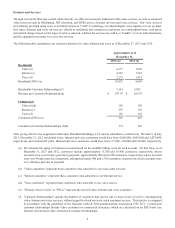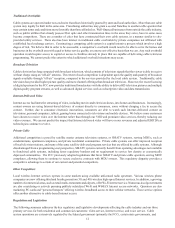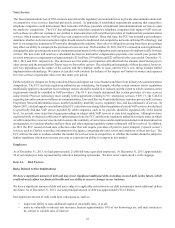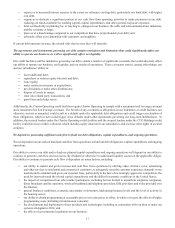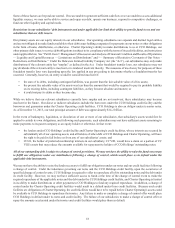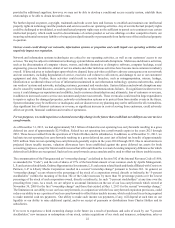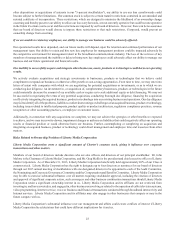Charter 2013 Annual Report Download - page 27
Download and view the complete annual report
Please find page 27 of the 2013 Charter annual report below. You can navigate through the pages in the report by either clicking on the pages listed below, or by using the keyword search tool below to find specific information within the annual report.13
many local governments. A failure to comply with these regulations could subject us to substantial penalties. Our business can
be dramatically impacted by changes to the existing regulatory framework, whether triggered by legislative, administrative, or
judicial rulings. Congress and the FCC have frequently revisited the subject of communications regulation and they are likely
to do so again in the future. We could be materially disadvantaged in the future if we are subject to new regulations that do not
equally impact our key competitors. We cannot provide assurance that the already extensive regulation of our business will not
be expanded in the future.
Video Service
Cable Rate Regulation. Federal regulations currently restrict the prices that cable systems charge for the minimum level of video
programming service, referred to as “basic service,” and associated equipment. All other video service offerings are now universally
exempt from rate regulation. Although basic service rate regulation operates pursuant to a federal formula, local governments,
commonly referred to as local franchising authorities, are primarily responsible for administering this regulation. The majority
of our local franchising authorities have never been certified to regulate basic service cable rates (and order rate reductions and
refunds), but they generally retain the right to do so (subject to potential regulatory limitations under state franchising laws), except
in those specific communities facing “effective competition,” as defined under federal law. We have secured FCC recognition of
effective competition, and become rate deregulated, in many of our communities.
There have been frequent calls to impose expanded rate regulation on the cable industry. Confronted with rapidly increasing cable
programming costs, it is possible that Congress may adopt new constraints on the retail pricing or packaging of cable programming.
Any such constraints could adversely affect our operations.
Federal rate regulations include certain marketing restrictions that could affect our pricing and packaging of service tiers and
equipment. As we attempt to respond to a changing marketplace with competitive pricing practices, we may face regulations that
impede our ability to compete.
Must Carry/Retransmission Consent. There are two alternative legal methods for carriage of local broadcast television stations
on cable systems. Federal “must carry” regulations require cable systems to carry local broadcast television stations upon the
request of the local broadcaster. Alternatively, federal law includes “retransmission consent” regulations, by which popular
commercial television stations can prohibit cable carriage unless the cable operator first negotiates for “retransmission consent,”
which may be conditioned on significant payments or other concessions. Popular stations invoking “retransmission consent” have
been demanding substantial compensation increases in their recent negotiations with cable operators, thereby significantly
increasing our operating costs.
Additional government-mandated broadcast carriage obligations could disrupt existing programming commitments, interfere with
our preferred use of limited channel capacity, and limit our ability to offer services that appeal to our customers and generate
revenues.
Access Channels. Local franchise agreements often require cable operators to set aside certain channels for public, educational,
and governmental access programming. Federal law also requires cable systems to designate up to 15% of their channel capacity
for commercial leased access by unaffiliated third parties, who may offer programming that our customers do not particularly
desire. The FCC adopted new rules in 2007 mandating a significant reduction in the rates that operators can charge commercial
leased access users and imposing additional administrative requirements that would be burdensome on the cable industry. The
effect of the FCC's new rules was stayed by a federal court, pending a cable industry appeal and an adverse finding by the Office
of Management and Budget. Although commercial leased access activity historically has been relatively limited, increased activity
in this area could further burden the channel capacity of our cable systems.
Ownership Restrictions. Federal regulation of the communications field traditionally included a host of ownership restrictions,
which limited the size of certain media entities and restricted their ability to enter into competing enterprises. Through a series
of legislative, regulatory, and judicial actions, most of these restrictions have been either eliminated or substantially relaxed.
Changes in this regulatory area could alter the business environment in which we operate.
Pole Attachments. The Communications Act requires most utilities owning utility poles to provide cable systems with access to
poles and conduits and simultaneously subjects the rates charged for this access to either federal or state regulation. In 2011, the
FCC amended its existing pole attachment rules to promote broadband deployment. The 2011 order allows for new penalties in
certain cases involving unauthorized attachments, but generally strengthens the cable industry's ability to access investor-owned
utility poles on reasonable rates, terms, and conditions. It specifically maintains the basic rate formula applicable to “cable”
attachments, but reduces the rate formula previously applicable to “telecommunications” attachments. Several electric utilities
sought review of the 2011 order at the FCC and the D.C. Circuit Court of Appeals, and the FCC and the court subsequently affirmed



